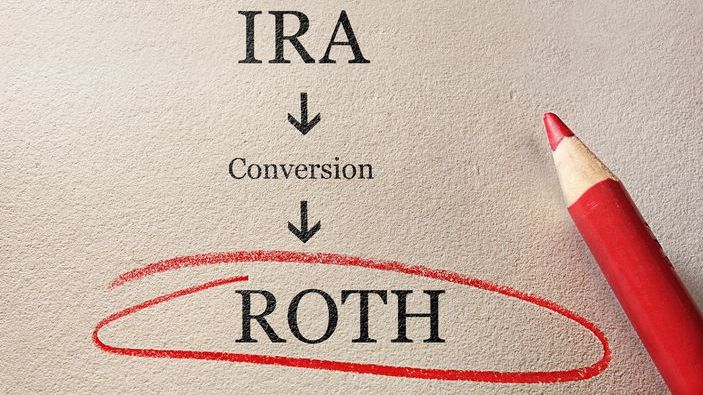If you’re nearing retirement and you have a sizeable IRA balance, you face some significant decisions surrounding required withdrawals and taxes. Converting a traditional IRA into a Roth account is one move that can increase your planning flexibility. And even at 64 years old, shifting an account from a tax-deferred to tax-free status can result in greater control over income distributions, as well as potential estate planning benefits.
A financial advisor can help decide if Roth conversions are right for you. Speak with a fiduciary financial advisor today.
Roth Conversion Essentials
When you do a Roth conversion, you transfer funds from a traditional traditional IRA into a Roth IRA. There are no age restrictions on doing Roth conversions, but the assets must remain in the Roth IRA for at least five years after the conversion or they could be subject to a 10% early withdrawal penalty. Then again, this five-year rule on Roth conversions does not apply to people who have reached age 59 ½.
Roth conversions can be appealing because withdrawals from Roth accounts can be made tax-free, as long as the account was opened five years before the withdrawal. Roth accounts are also not subject to required minimum distributions (RMDs). That means retirees don’t have to worry about RMDs adding taxable income and pushing them into a higher marginal income tax bracket.
However, the immediate tax bill that comes due is the biggest challenge of doing a Roth conversion. If you do such a conversion, the funds in your IRA that were previously tax deferred are treated as taxable income in the year the conversion happens. A 64-year-old couple converting $750,000 from a traditional IRA to a Roth would generate a substantial tax obligation. If the $750,000 is treated as ordinary income, as it likely would be, it could push you into the highest 37% federal bracket and result in a six-figure tax bill.
Keep in mind that a financial advisor can help you project how much you could owe in taxes on a Roth conversion and potentially develop an alternative strategy.
Roth Conversion Options

The all-at-once conversion method is not the only approach. It’s also possible to spread the conversion out over several years, potentially reducing the tax impact. If you and your spouse are both retired and receive $44,544 in combined annual Social Security benefits (the average retirement benefit in December 2023 was $1,856 per month) there are several ways that a $750,000 conversion could play out.
If you convert the entire $750,000 IRA balance into a Roth IRA in tax year 2024, the entire sum will likely be treated as ordinary income with taxes due on your next return. After taking the standard deduction of $29,200 available to married couples filing jointly, $720,800 of this amount would be taxable. This would push you and your spouse into the top 37% marginal tax bracket and produce a tax bill of approximately $193,000.
Alternatively, by converting $75,000 per year for 10 years, you would only owe income tax on the $75,000 that gets converted each year. With that income, $37,862 of your Social Security benefits would be subject to income taxes, giving you a taxable income of $83,662.
Assuming tax brackets remain similar to the ones for 2024, you would owe just $9,575 or so in annual federal income taxes on each $75,000 conversion. Over the full 10 years, you would pay approximately $96,000 in income taxes, saving you around $100,000 compared to the all-at-once conversion option.
A financial advisor can help you run calculations like this one and then make decisions based on those projections.
Choosing Your Approach

When deciding whether to convert a traditional IRA into a Roth, you have to look at more than just federal income taxes on the converted amount. Other concerns include state income taxes, taxes on Social Security benefits and potential estate planning consequences.
One thing you’ll want to do is compare current tax rates to what they could be in the future. The current tax brackets, which were put in place in 2018 under the Tax Cuts and Jobs Act, are set to revert to their pre-2018 levels (adjusted for inflation) in 2025. Doing a Roth conversion when tax rates seem likely to increase could save you money despite upfront taxes owed on the conversion. However, you may want to discuss these kinds of tax planning questions with a financial advisor.
Estate planning considerations are also vital. Roth IRA assets can pass tax-free to heirs, but if you plan to leave a bequest to charity, it may be wiser to keep funds in traditional tax-deferred vehicles.
The income that’s realized from Roth conversions can also impact your Medicare premiums and tax credits so consider those effects as well. Furthermore, you’ll need access to non-retirement cash to pay conversion taxes. Otherwise, you might have to liquidate investments at possibly inopportune times. A financial advisor can run projections and help you determine when to do a Roth conversion and how much.
Bottom Line
Roth IRA conversions allow investors to take more control of how their money is ultimately taxed, while also unlocking tax-free income in retirement. Partial conversions carried out over multiple years may result in a lighter tax liability. However, comparing current and future tax rates, analyzing total costs, weighing estate planning considerations, and modeling different Roth conversion approaches tailored to your particular financial situation are all key parts of this process.
Retirement Planning Tips
- A Roth conversion decision warrants an in-depth review from all angles. Consider enlisting a financial advisor to help you assess if and how to do a large IRA conversion. Finding a financial advisor doesn’t have to be hard. SmartAsset’s free tool matches you with up to three vetted financial advisors who serve your area, and you can have a free introductory call with your advisor matches to decide which one you feel is right for you. If you’re ready to find an advisor who can help you achieve your financial goals, get started now.
- Before making any major decisions about what to do with your retirement funds, you’ll want to know how much you’re likely to have saved up when retirement arrives. SmartAsset’s retirement calculator can help you project how much you could have and whether you’re on track to meet your recommended savings target.
Photo credit: ©iStock.com/shapecharge, ©iStock.com/zimmytws, ©iStock.com/fizkes
